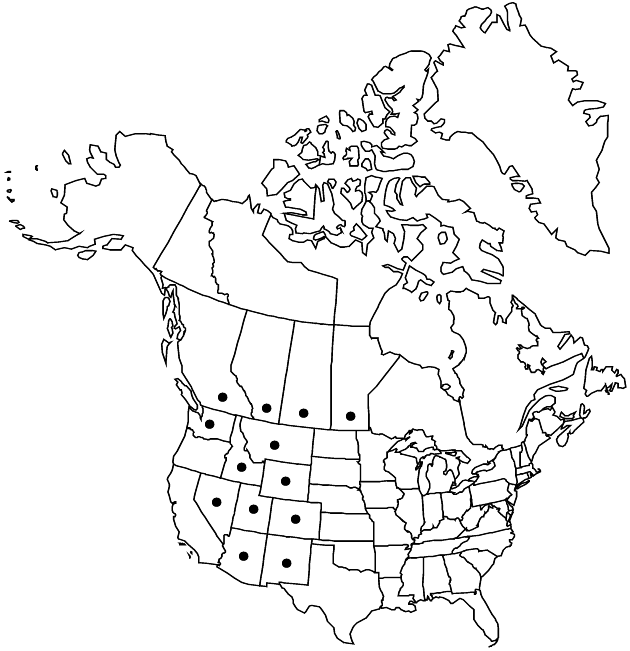Difference between revisions of "Solidago lepida var. salebrosa"
Sida 20: 1611. 2003.
imported>Volume Importer |
GeoffLevin (talk | contribs) m (Fixed italics in discussion) |
||
| (One intermediate revision by one other user not shown) | |||
| Line 54: | Line 54: | ||
|elevation=0–2900+ m | |elevation=0–2900+ m | ||
|distribution=Alta.;B.C.;Man.;Sask.;Ariz.;Colo.;Idaho;Mont.;Nev.;N.Mex.;Utah;Wash.;Wyo. | |distribution=Alta.;B.C.;Man.;Sask.;Ariz.;Colo.;Idaho;Mont.;Nev.;N.Mex.;Utah;Wash.;Wyo. | ||
| − | |discussion=<p>Variety salebrosa strongly resembles <i>Solidago canadensis</i>, and is found throughout most of the Rocky Mountains in the United States and adjacent Canada. It has been included in <i>S. canadensis</i> by many authors (e.g., A. Cronquist 1994). In extreme forms the array is broader than tall with long, arching proximal branches. Hairier plants can be similar in appearance to <i>S. altissima</i>; the latter is usually not glandular and is much hairier. Glabrate plants of <i></i>var.<i> salebrosa</i> can be difficult to distinguish from hexaploid <i>S. gigantea</i> near and in the mountains from Alberta south to New Mexico. Glabrate plants in the mountains often treated as <i>S. gigantea</i> are glandular and belong in <i>S. lepida </i>var.<i> salebrosa</i>. Small-headed diploids found in the Rocky Mountains from southern British Columbia to Colorado are usually sparsely glandular and could be confused with short-array forms of <i>S. elongata</i>.</p> | + | |discussion=<p>Variety <i>salebrosa</i> strongly resembles <i>Solidago canadensis</i>, and is found throughout most of the Rocky Mountains in the United States and adjacent Canada. It has been included in <i>S. canadensis</i> by many authors (e.g., A. Cronquist 1994). In extreme forms the array is broader than tall with long, arching proximal branches. Hairier plants can be similar in appearance to <i>S. altissima</i>; the latter is usually not glandular and is much hairier. Glabrate plants of <i></i>var.<i> salebrosa</i> can be difficult to distinguish from hexaploid <i>S. gigantea</i> near and in the mountains from Alberta south to New Mexico. Glabrate plants in the mountains often treated as <i>S. gigantea</i> are glandular and belong in <i>S. lepida </i>var.<i> salebrosa</i>. Small-headed diploids found in the Rocky Mountains from southern British Columbia to Colorado are usually sparsely glandular and could be confused with short-array forms of <i>S. elongata</i>.</p> |
|tables= | |tables= | ||
|references= | |references= | ||
| Line 77: | Line 77: | ||
|publication year=2003 | |publication year=2003 | ||
|special status=Endemic | |special status=Endemic | ||
| − | |source xml=https:// | + | |source xml=https://bitbucket.org/aafc-mbb/fna-data-curation/src/2e0870ddd59836b60bcf96646a41e87ea5a5943a/coarse_grained_fna_xml/V19-20-21/V20_337.xml |
|tribe=Asteraceae tribe Astereae | |tribe=Asteraceae tribe Astereae | ||
|genus=Solidago | |genus=Solidago | ||
Latest revision as of 14:02, 10 December 2021
Heads in pyramidal paniculiform arrays, proximal branches arching to recurved. 2n = 18, 36, 54.
Phenology: Flowering Aug–Oct.
Habitat: Dry to moist sandy and gravelly soils, meadows, along streams and rivers
Elevation: 0–2900+ m
Distribution

Alta., B.C., Man., Sask., Ariz., Colo., Idaho, Mont., Nev., N.Mex., Utah, Wash., Wyo.
Discussion
Variety salebrosa strongly resembles Solidago canadensis, and is found throughout most of the Rocky Mountains in the United States and adjacent Canada. It has been included in S. canadensis by many authors (e.g., A. Cronquist 1994). In extreme forms the array is broader than tall with long, arching proximal branches. Hairier plants can be similar in appearance to S. altissima; the latter is usually not glandular and is much hairier. Glabrate plants of var. salebrosa can be difficult to distinguish from hexaploid S. gigantea near and in the mountains from Alberta south to New Mexico. Glabrate plants in the mountains often treated as S. gigantea are glandular and belong in S. lepida var. salebrosa. Small-headed diploids found in the Rocky Mountains from southern British Columbia to Colorado are usually sparsely glandular and could be confused with short-array forms of S. elongata.
Selected References
None.